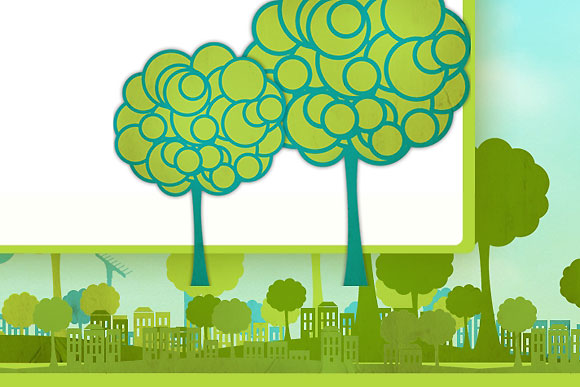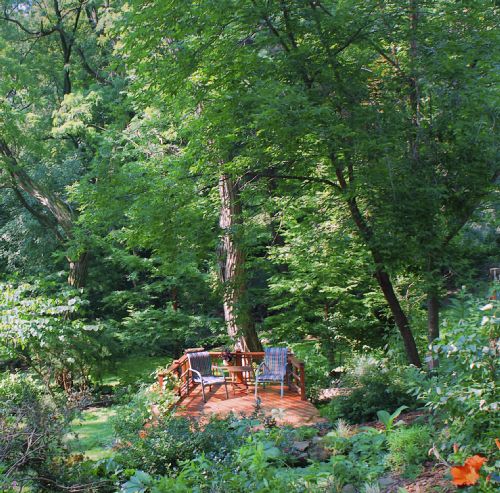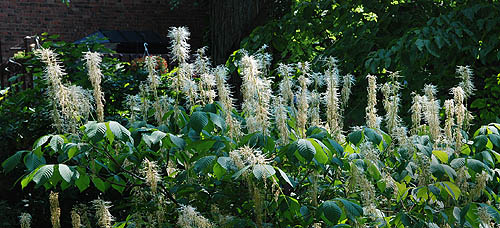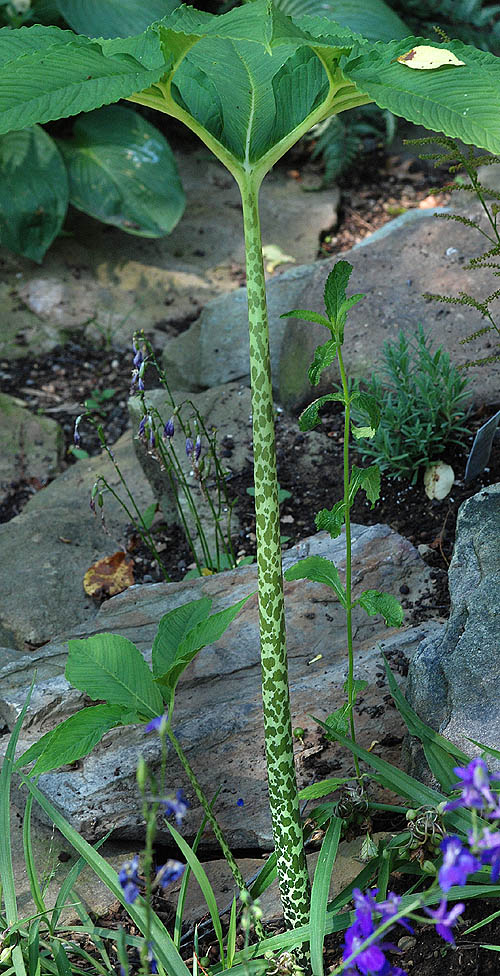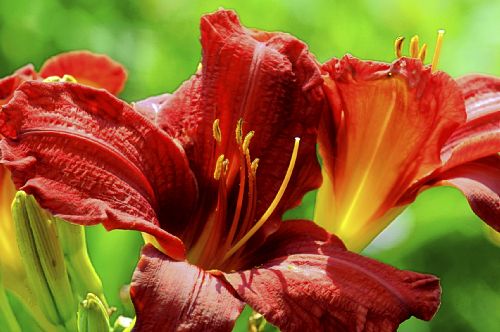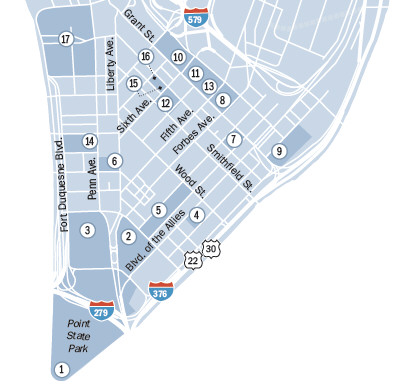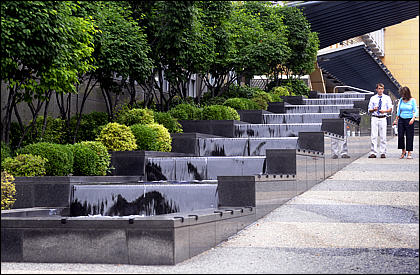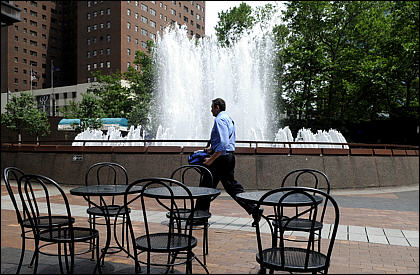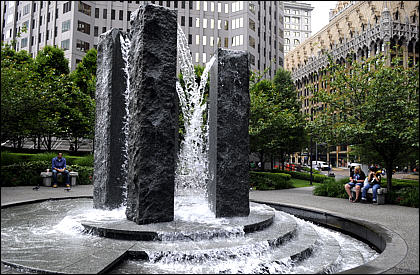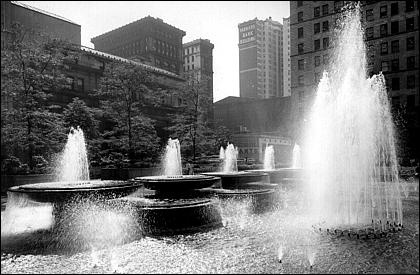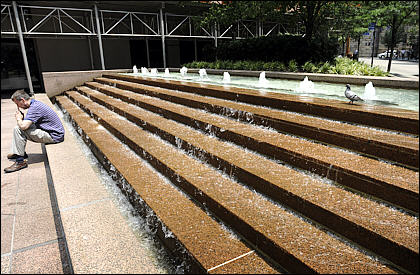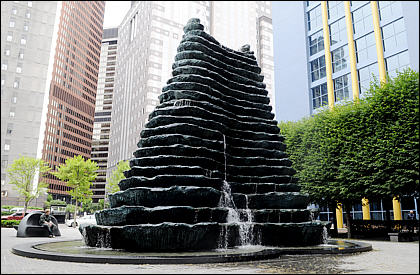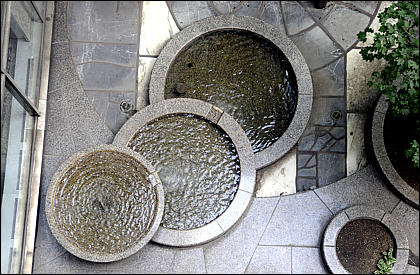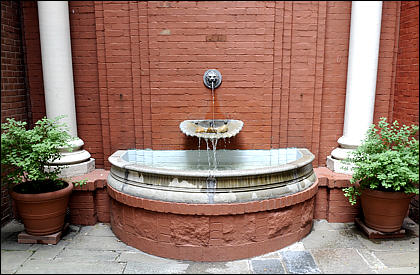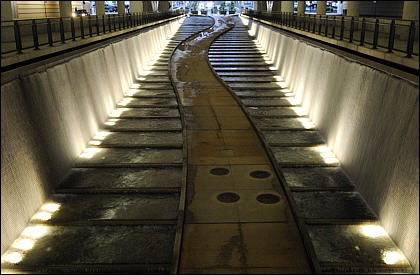
Author Archives: ryochum
-
Steel Valley Agency Eyes Old Gym For After-School Use
By Chris Ramirez
PITTSBURGH TRIBUNE-REVIEW
Thursday, July 15, 2010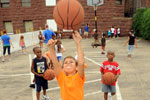
Christian Michaels, 8, shoots hoops during a summer camp at Homestead United Prebyterian Church in Homestead. The camp is organized by the Methodist Union of Social Agencies, or MUSA, which wants to run after school programs for middle school children in the Steel Valley Council of Governments' gymnasium. James Knox | Tribune-Review
Decades ago, the old gymnasium attached to the Steel Valley Council of Governments building was the place to go for pick-up basketball games and summer youth camps.
Not so much now.
Amid the walls, streaked with unsightly graffiti and time-yellowed pin-ups, the Rev. Jim Cannistraci sees potential.
He and a small-but-growing band of community leaders are trying to generate local support — and money — to convert the aging gym into a state-licensed center for programs that cater to middle school children.
“This isn’t my dream. It’s the dream of the community,” said Cannistraci, executive director of the Methodist Union of Social Agencies. “People want this and people need this.”
They envision starting a program that would see to the needs of children from West Homestead, Munhall and Homestead, where half the population is black and one in four residents lives below the poverty line, according to U.S. Census figures.
Among services Cannistraci hopes can be offered at the center would be help with homework, access to computer labs and career exploration sessions. The Methodist Union wants the program to start Sept. 1, but needs to raise more than $100,000 before then for improvements to the gym.
Cannistraci envisions the program serving about 50 students by the end of the upcoming school year, but expects it eventually to cater to as many as 125.
“A lot of kids get out of school at three, but their parents are still at work. That’s also when they face a lot of temptation to do things that can get them in trouble,” said Douglas R. Spencer, executive director for the Allegheny Children’s Initiative, a South Side nonprofit pushing for the change. “That time needs to be occupied with structured activities.”

RaVyn Wright, 9, (left) and Edaiza Sands, 10, have fun playing computer games during a summer camp at Homestead United Prebyterian Church in Homestead. The camp is organized by the Methodist Union of Social Agencies, or MUSA, which is looking to generate funds to renovate the former gym and building that belonged to Homestead High School for an after school program that would see to the needs of children from West Homestead, Munhall and Homestead.
Homestead does not have a YMCA, Boys and Girls clubs or a private community center for middle school students to go to in the afternoon as neighboring communities do. A local chapter of the Salvation Army offers a free after-school program for children ages 6 to 12, and Methodist Union of Social Agencies holds after-school programs at Barrett and Park elementary schools.
For more than 80 years, the Methodist Union has aided families and children of the Mon and Steel valleys. The past three decades have been among the most challenging as the two areas struggle to find solid financial footing in the wake of the steel industry’s collapse.
Last week, the Steel Valley Council of Governments, which owns the gym, examined the prospect of an after-school program at a public meeting.
The gym for years belonged to Homestead High School and often was the backdrop to basketball games and large student assemblies. But that changed in 1979 when the Homestead school district merged with West Homestead and Munhall to form the Steel Valley School District.
The Allegheny Works program, which offered job-training programs and operated out of the old high school as the collapse of the steel industry began in the 1980s, used the gym for workshops for many years. These days, however, the gym is used only sparingly.
The Steel Valley Council of Governments says the gym is habitable, but $750,000 is needed to make it usable for a variety of purposes in addition to the after-school program.
-
Greening the South Side: Residents Plant Nearly Two Dozen Street Trees
Wednesday, January 13, 2010
South Side will begin to look greener in the spring thanks to Kim Collins.
Back in March, she and a friend were talking over wine one night, trying to think of something they could do in their community. “And we came up with trees,” says Collins. “I live on Wharton Street and there was, like, one tree on my block.”
Collins, who is the owner and creative director of South Side-based graphic design firm Blue Tomato, worked to create the South Side Pittsburgh Tree Project with the help of neighbors and nearly 45 volunteers.
In October, they planted 21 trees ranging from maples to lilacs on the 1900 block of Wharton Street.
To start the project, Collins researched and found the TreeVitalize program, a partnership between five organizations including the city, county and state and two nonprofits, including the Western Pennsylvania Conservancy. The goal of the program, according to its website, is to “plant 20,000 trees by 2012 throughout the Pittsburgh region in order to improve quality of life and the environment.”
Once assisted by TreeVitalize, Collins and other leaders went door-to-door asking residents if they would water and take care of trees if the South Side Pittsburgh Tree Project took care of planting. Twenty-one residents agreed to this arrangement for the first planting.
Riverset Credit Union aided the project by paying for the website and marketing, as well as a banner on Sarah and 11th Streets that asks, “Want A Free Tree?”
The South Side Pittsburgh Tree Project wants add at least 300 to 400 more trees in the South Side over the next four years.
Currently, 4,500 trees have been planted in Allegheny County through TreeVitalize.
Sign up to receive Pop City each week.
Writer: Pop City Staff
Source: Kim Collins, South Side Pittsburgh Tree ProjectImage courtesy of South Side Pittsburgh Tree Project
-
Rain Barrels and Rain Gardens: Nine Mile Run Watershed Association Looks Ahead
Wednesday, July 14, 2010
This Saturday night, the Nine Mile Run Watershed Association (NMRWA) will celebrate another year of progress at their annual fundraiser.
In lower Frick Park, near the confluence of the Fern Hollow and Nine Mile Run streams, “A Midsummer Night’s Storm” will include food and drink from Point Brugge Café and Make Your Mark Artspace & Coffeehouse. Rick Sebak, the Mon River Ramblers, J. Malls and Hi Top Wrangler will be on hand for the festivities.
The goal will be to raise funds for the association’s environmental stewardship programs, including the Rain Barrel Initiative and Rain Garden Pilot Project.
One of the environmental challenges in the Pittsburgh area is that rain storms cause runoff that brings chemicals and pollutants from our streets and sewers down into the rivers. The Association has been battling that by introducing rain barrels and teaching homeowners to develop rain gardens to keep rainfall on their own property.
“We now have over 1300 rain barrels just in our watershed alone, which is probably one of the highest densities for a rain barrel program in the country,” says Lisa Brown, director of operations and outreach at NMRWA. “Within the watershed, we install and we maintain them. And we continually keep in contact with the rain barrel owners,” to create an ongoing relationship of outreach and teaching.
The Rain Garden project is “sort of a separate project because many, many people don’t necessarily want to use rain barrels. They are interested in something that is, I guess, more aesthetically appealing,” Brown says. “So we teach them to disconnect downspouts and create a rain garden, as part of a suite of options for homeowners.”
Pop City Media
Writer: Melissa Rayworth
Source: Lisa Brown, NMRWA
Images courtesy of NMRWA -
Could New Teams Save Old Mellon Arena?
Wednesday, July 14, 2010By Mark Belko, Pittsburgh Post-GazetteFor some, it’s a pipe dream. For Aubrey Bruce, it’s a mission.
A former music promoter, Mr. Bruce hopes to save Mellon Arena by recruiting an arena football team, a Women’s National Basketball Association team and an American Basketball Association team to play there.
It’s debatable which is the biggest challenge.
Still, Mr. Bruce, who writes sports columns for the New Pittsburgh Courier, has formed Seastorm Sports Management Group with hopes of salvaging Mellon Arena by recruiting teams to play under its iconic silver dome.
“We understand that it is going to be a hard road to climb,” he acknowledged.
Mr. Bruce has talked to Rob Pfaffmann, the Downtown architect who is leading the effort to save the Igloo about his ideas. He also plans to make a presentation to the city-Allegheny County Sports & Exhibition Authority as part of the historic review process, but has yet to do so. He said his main objective is to rescue Mellon Arena, which was slated for demolition as part of a plan by the Penguins to redevelop the property with offices, residences and commercial ventures.
“Our goal is to save the Civic Arena,” he said. “It’s symbolic of Pittsburgh shedding its industrial skin and moving into the electronic age. It’s a very important symbol, I think, of Pittsburgh.”
Mr. Bruce has had some preliminary contact with the Arena Football League about his idea, but has yet to talk to Commissioner Jerry Kurz or an owner or prospective owner with any interest in placing a team in Pittsburgh.
However, Mr. Kurz, at a news conference in February, did say that the 15-team reconstituted league, under new leadership after folding last year, had an interest in expanding into Pittsburgh and several other cities by 2011.
Linnea Coulter, manager of media services for the Arena Football League, said she had talked to Mr. Bruce about a month and a half ago and forwarded his information to Mr. Kurz. She said she has not heard anything since then.
Mr. Bruce has had no formal contact with the WNBA, but said he had spoken with a marketing representative with the affiliated National Basketball Association. He said he also had talked to Joe Newman, the American Basketball Association CEO. The ABA currently has a team in Pittsburgh, the Phantoms, which played at Carnegie Library in Homestead last season.
Neither Mr. Newman nor Ron Howard, director of WNBA communications, could be reached for comment.
While Mr. Bruce readily acknowledges that he has yet to get anything close to a commitment from any of the leagues, he believes teams would be interested in playing in a redesigned Mellon Arena with seating for 5,000 to 6,000 people.
He is hoping the SEA, which owns the old building, will issue a moratorium that would prevent any demolition for at least a year.
There are big obstacles, however. Unclear is who would pay the millions of dollars to renovate Mellon Arena or foot the bill for the costs of operating and maintaining it. The SEA has estimated that insurance and utility costs alone could run as much as $100,000 a month. Mr. Bruce believes rent from the teams would pay part of it.
The former promoter also may have to battle the Penguins ownership, which isn’t keen about the idea of keeping two arenas side by side. And an arena football team could fill open dates at the new arena.
Penguins President David Morehouse said Tuesday that revenues from arena football and WNBA and ABA basketball would not pay for the cost of redoing and maintaining the arena.
“If an arena football team came to Pittsburgh, they would want to play in the brand new Consol Energy Center,” he said.
Mr. Morehouse also questioned the viability of plans floated in an effort to save Mellon Arena. “There are all kind of cockamamy ideas out there. The question is: Does anyone have anything that’s financially viable?” he asked.
-
Macy’s Puts Historic Downtown Building Up For Sale
By Kim Leonard and Sam Spatter, PITTSBURGH TRIBUNE-REVIEW
Thursday, July 1, 2010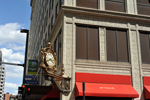
The clock outside the Macy's store has lasted longer than the name above the door of the Downtown fixture, which in 1885 became home to a store doing business as Kaufmann Brothers. Justin Merriman | Tribune-Review
Macy’s is putting its historic, 13-story Downtown store on the selling block, with plans to lease back part of the space.
The department store chain didn’t name an asking price for the landmark that fills a block on Smithfield Street, between Forbes and Fifth avenues. Macy’s retail operations fill 10 floors, and offices are on part of a separate floor.
Macy’s Inc. has been considering its options for the Downtown building — which was the flagship store of Kaufmann’s for most of its history — during the past year or two, spokesman Jim Sluzewski said Wednesday.
“Our initial goal is to sell the building, and then lease back the space we need for a store and offices,” he said. If that can’t be done, Macy’s could find tenants for unused or now-underused space in the building, he said.
Sluzewski said the amount of space Macy’s retains in the building will “depend on discussions with a potential buyer.”
Commercial real estate firm Cassidy Turley of St. Louis is marketing the store, which has 750,000 square feet of space, nearly 14 football fields.
Macy’s is jumping into the Downtown real estate market at a time when other major buildings also are for sale — Gateway Center, the Henry W. Oliver Building, EQT Tower, the Regional Enterprise Center and the Red Cross Building.
“The Downtown Pittsburgh market is extremely active now and is attracting a lot of interest,” said Pat Sentner, a principal with real estate firm NAI Pittsburgh Commercial.
The department store chain’s intent to lease part of the building makes it attractive to buyers, he said. But what’s important is how much space the retailer wants, and for how long, he said.
“If 75 percent or more of the building is part of the leaseback arrangement, that could attract an institutional type of investor” such as an investment group or foundation, Sentner said. If Macy’s wants half the space or less, a corporation or law firm might want to buy the building and use most of it for offices, he said.
Preserving the store in some form is key to keeping Downtown healthy and vibrant, observers said.
“It’s important to keep Macy’s Downtown and continue it as a retailer of excellent merchandise,” said Mike Edwards, president of the Pittsburgh Downtown Partnership. “I’ve seen it in other cities. Department store owners are retailers who don’t want to own real estate.”
Retail expert C. Britt Beemer said Macy’s closed stores in several downtown areas in recent years. “Pittsburgh is fortunate to have one, and it’s good to maintain downtown stores — they have a history and a sense of integrity.”
“Department stores used to be major property owners in many cities. Now they’re mainly tenants in malls and shopping centers,” said Beemer of America’s Research Group in Charleston, S.C.
Cincinnati-based Macy’s owns 469 of its 850 Macy’s and Bloomingdale’s stores. Spokesman Sluzewski said Macy’s always is looking to maximize its use of space in stores. The company maintains many downtown stores, he said, citing 15 other examples.
Patricia Edwards of Storehouse Partners LLC in Seattle said department store chains, especially in the rough economy of recent years, “are really trying to make sure each individual store is profitable, as opposed to just the chain itself.”
In September 2006, Macy’s kicked off its new presence Downtown and elsewhere in the region with a block party on Smithfield Street. It promised to keep the landmark corner clock at Smithfield and Fifth, the Tic Toc restaurant on the first floor, holiday events and other favorite Kaufmann’s features.
Still, Duquesne University marketing professor Audrey Guskey said shoppers in the region gave Macy’s a lukewarm reception.
“A lot of people were disappointed in the quality of merchandise, the service and the hours,” she said. “Also, Macy’s goal was to become a national department store, and they were very cookie-cutter — the Pittsburgh stores were like Cleveland, L.A. and Chicago.” Macy’s since then has been tailoring merchandise to various regions’ tastes, Guskey added.
In the past three decades, Downtown has lost four department stores, including a Lord and Taylor department store next to the Macy’s building.
Macy’s sales nationwide last year totaled $23.5 billion, down 5.6 percent from 2008. The company’s profit was $350 million, after a $4.8 billion loss in 2008.
____________________________________________________________________________________
Key dates:• 1877: Brothers Jacob and Isaac Kaufmann open a four-story store at Smithfield Street and what now is Forbes
Avenue, moving their tailoring business from the South Side.
• 1885: Store becomes Kaufmann Brothers, filling a block between Forbes and Fifth avenues.
• 1913: Another expansion brings the store to 12 stories.
• 1946: May Department Stores Inc. acquires Kaufmann’s.
• 1955: A 10-story addition on the store’s Fifth Avenue side is built, along with a parking garage.
• 2002: May closes Kaufmann’s headquarters on the Downtown store’s upper floors. About 1,200 jobs are lost.
• 2005: Macy’s parent, Federated Department Stores Inc., buys May company.
• 2006: Kaufmann’s and department stores in other cities that were part of May are changed to the Macy’s name.
-
Mount Lebanon Gardener Turns Destruction into Opportunity
Saturday, July 10, 2010By Kevin Kirkland, Pittsburgh Post-Gazette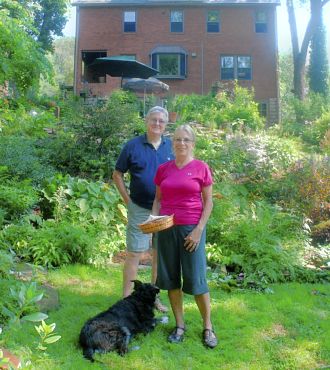
Larry Roberts / Post-Gazette Wes and Nancy Smith will open their garden for the Mt. Lebanon Library's 20th Anniversary Garden Tour.
In more than 25 years of Pittsburgh gardening, Nancy Smith has tested, sometimes fooled and been humbled by Mother Nature.
She has succeeded with plants that supposedly need more sunlight or aren’t supposed to survive our winters. And she has lost perfectly suitable plants and trees to beastly weather, critters big and small and for no earthly reason at all. She tries to see major disasters like falling trees as an opportunity for change.
“It opens something up,” she says.
But the past five months have tested even the most hopeful gardener’s patience.
February’s snowmageddon brought down three large junipers, a chamaecyparis and a Leyland cypress. A great blue heron ate one large koi and more than half of the dozen goldfish in two ponds, and birds and rodents teamed up to steal her entire crop of strawberries. Then, recent high winds brought a neighbor’s 80-foot-tall black locust tree crashing down on a bed between the two ponds.
Despite it all, Mrs. Smith will have her garden looking great for Sunday’s Mt. Lebanon Library Garden Tour. Hers and six other gardens will be open from noon to 5 p.m. You can see more of her handiwork today, when the library holds its garden party in the courtyard that Mrs. Smith and 11 other volunteers have created over the past 10 years.
Everywhere she gardens, Mrs. Smith tries to keep a simple motto in mind:
Destruction is an opportunity for change.
Growing up near Baltimore, she failed in her first attempt at a garden at age 9. She had better luck shortly after she married Wes Smith, another Maryland native. Her parents brought lots of plants from their yard to the rental property the newlyweds shared. They moved to Mt. Lebanon in 1983 and volunteering at the library garden led to classes at what is now Phipps Garden Center. She became a master gardener in 1987 and was one of the leaders in designing and planting the library’s courtyard garden in 2000-01.
Meanwhile, Mrs. Smith was transforming her front and back yard, which once held mostly grass and a pedestrian collection of yews, forsythia, pachysandra and a few large spruce, locust and maple trees. The front still has a little grass nearly hidden by beds packed with interesting cultivars of phlox, sedum, ligularia, boxwood, hydrangea, yellow-leafed caryopteris and other perennials and shrubs. A fast-growing curly willow and red maple provide some shade.
The backyard originally held a concrete patio leading to a grassy hillside. But it soon changed.
“Every year we add something,” Mrs. Smith said.
She adds the plants (she says she’s a reformed “plant hog”) and her husband adds hardscape.
“I build or haul or cut grass,” he said modestly.
One year, Mr. Smith and his two sons-in-law replaced the concrete patio with one made of paver bricks laid in a herringbone pattern. Mrs. Smith created perennial beds around the old brick walls and grill, featuring larkspur, catchfly (Silene armeria), amsonia, New England asters, Joe Pye weed, cleome and an arum with exotic long leaves and giraffe-like spots on its thick stem.
When a willow fell nearby, Mrs, Smith asked her husband to build a pond near the stump. The next year he built a lower pond and linked them with a waterfall. The year the garden was on the Pittsburgh Botanic Garden Tour, he built a deck near the lower pond. He also built a cold frame and all the paths in the backyard.
With each piece of hardscape, Mrs. Smith creates adjoining beds. And as trees or limbs fall, she adds interesting shrubs and trees. She’s planted two metasequoias, a paperbark maple, redbud, fernleaf buckthorn, Carolina silverbell, Virginia juniper, ‘Diablo’ ninebark and a bottlebrush buckeye (Aesculus parviflora) that is just done blooming.
A shady bed near the bottom of the hill features Lenten rose, hostas, goatsbeard, ferns, variegated Solomon’s seal and Allegheny spurge, our native pachysandra.
“I like to do a lot of natives,” Mrs. Smith says, but her garden is not limited to them.
Her advice to gardeners who are just starting is simple: Take classes and talk to other gardeners about plants that do well here. And don’t overdo it.
“You can’t handle more than one new garden per year,” she said. “Otherwise, it’s a full-time job.”
Mt. Lebanon Library’s 20th anniversary Garden Tour runs from noon to 5 p.m. Sunday. The library will have a plant sale and free consultations with Penn State Master Gardeners and a member of the Pittsburgh Rose Society. Tickets are $12 in advance and $15 on tour day at the library. A pre-tour Garden Party will be held from 6 to 8 p.m. today in the library garden courtyard. Tickets are $25 per person and available at the door.
-
Tiny Gardener Designed Her House and Garden to Show Off Beloved Flowers
Saturday, July 10, 2010By Susan Banks, Pittsburgh Post-Gazette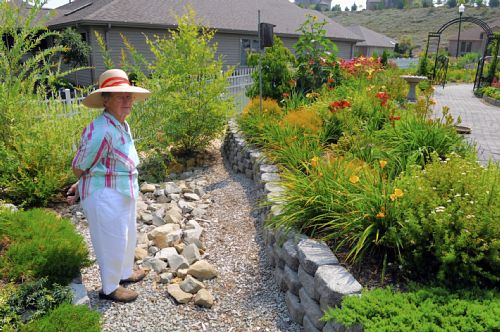
Irene Ciccarelli stands in front of the the willow, birch and pine trees in the catch basin area of her garden in North Huntingdon. Darrell Sapp / Post-Gazette
Overflowing flower beds with lots and lots of color, that’s Irene Ciccarelli’s cup of tea. Her 2-year-old garden, tucked in the new Lincoln Hills housing plan in North Huntingdon, stands out among the restrained landscaping of her neighbors. It’s not that she doesn’t like the neatly manicured plots around her home, she just likes flowers better.
She also likes being able to look out her windows and see flowers, so her garden has been designed to frame the property and be visible from the indoors, with only a small patch of lawn in the front. It’s also designed to be handicapped-accessible in case the energetic 80-year-old ever needs to use a wheelchair to tend it.
In less than two years, this diminutive woman has managed to plan, plant and tend a garden that will be open to visitors today from 10 a.m. to 2 p.m. for the Greenridge Garden Club and Norwin Art League’s 2010 Art in the Garden Tour. Mrs. Ciccarelli’s garden and six others will feature artwork by league members.
Mrs. Ciccarelli, who will be in her garden on the day of the tour, is no stranger to hard work. She recalls hoeing corn during the Depression, and also has fond memories of the flowers that her mother tended at their home in Irwin. The names of those flowers intrigued her and led to her lifelong enthusiasm for plants. This is her fourth garden — she has created three others in different areas of the country where she and her husband lived during their long marriage.
When her husband passed away several years ago, Mrs. Ciccarelli, a retired schoolteacher, moved back here to be closer to family. While staying with her sister, she started looking for a new home that would meet all of her needs. The house she is in now was under construction when she purchased it, allowing her to customize the inside, adding more windows and doors, and also alter the outside hardscape. When moving day came, there was no landscaping, just dirt. She had crummy soil, a drainage ditch and a wickedly steep hillside in the back. In other words, she had a Pittsburgh yard.
She first amended the soil by double-digging the flower beds and adding 10 to 12 truckloads of mushroom manure — by herself. Then planting commenced.
When asked if she had a grand plan, she shrugs and says she made it up as she went along. She did know she wanted continuous color and lots of perennials, which she loves. As inspiration, she used Anne Hathaway’s garden in Shottery, England, considered the quintessential cottage garden. She laughs when she recounts that on a visit to that garden she discovered it takes six or eight full-time gardeners to keep it looking perfectly informal.
Though a neighbor cuts her small patch of grass, Mrs. Ciccarelli tends this garden herself, usually in the early part of the day. The beds are overflowing with coneflowers, bee balm, clematis, heuchera, lady’s mantle, daylilies, liatris, bergenia and more; many are now happily self-sowing. Because she mulches heavily, she hasn’t had to start watering until just this past week.
When asked if she had a favorite nursery, she replied that she buys lots of her plants from the damaged table at Lowe’s. She says it’s a great place to find inexpensive plants that just need a little tender loving care, but she cautions bargain hunters to go early in the morning when the pickings are good.
Sometimes, she’ll splurge on a special specimen such as the Bonica rose planted on a trellis. She found a gate/trellis at a discount store and installed that on the side of the house. Conifers are plopped into the beds to provide winter interest and small ornaments are scattered throughout. Her attention to detail is seen in the garden and in her home, both of which were lavishly decorated for the July Fourth holiday.
Her next big project will be the extremely steep bank behind the house. She has started planting it with shrubs and plans on fencing some of it off to discourage the deer, which invade during the winter.
And while the garden will never be finished, she says, “I’ve accomplished what I set out to do (two years ago). I have year-round color.”
Tickets for the Art in the Garden Tour are $10 and can be purchased at Vargos Hallmark Shops, Norwin Town Square and Norwin Hills Shopping Center; Belaks Flower Shop in Irwin and the Greensburg Garden Center, Greensburg.
-
Pittsburgh Offers Plenty of Refreshing Water Havens During the Summer Months: A Walking Tour of the City’s Fountains and Water Feaures
Sunday, July 11, 2010By Bill Toland, Virginia Linn, Patricia Lowry, Marylynne Pitz and Katy Buchanan, Pittsburgh Post-GazetteOur crown jewel fountain at Point State Park (No. 1 on the map above) is dry until 2012 while it undergoes repairs, and a few others also need work, but there are plenty of other burbling basins to enjoy in the city. Some are old, some are new, some tucked away and some in plain view. But they all make a splash, so put on your walking shoes, follow this guide and discover the cool fountains of Downtown Pittsburgh.
__________________________________________________________________________ 1. Point State Park
DETAILS: When it rose for the first time on July 23, 1974, the fountain in Point State Park sprayed a geyser of water that was 150 feet high.
At its formal dedication that August, the magnificent column of water signified the park’s completion, the importance of rivers to the region’s growth and the city’s first renaissance.
The fountain cost $1 million and the 6,000 gallons of water that circulate through it each minute come from Pittsburgh’s “fourth river,” which flows 54 feet underground. When running, 800,000 gallons of city water recirculate through it daily.
Designed by Ralph Griswold and Charles Stotz, the fountain has experienced its share of problems, including flooding that deposits mud, silt, logs and other debris.
Between 2007 and 2012, Point State Park and its fountain will have been renovated at a cost of $42 million.
“It’s the largest park project in commonwealth history,” said Edward Patton, director of capital projects for Riverlife, a public-private partnership whose mission is to improve the region’s riverfronts.
The fountain’s circular base is 200 feet in diameter. Plans call for cleaning its circular granite rim and adding a second, higher tier over which water will flow into the basin at the rim level. People standing on the great lawn will be able to see the overflow tier.
The plaza around the fountain will be raised 18 inches, making it easy for visitors to sit on the rim and access its water. The sandstone block plaza will be dug up, cleaned and relaid. For the present, the fountain is inaccessible during construction.
2. TrizecHahn Plaza (formerly Equitable Plaza)Bounded by Liberty Avenue, Stanwix Street and Boulevard of the Allies
COMPLETED: 1961
DETAILS: The plaza sandwiched by the former state office building on the west and Gateway Four and the Verizon Building on the east was designed by Simonds and Simonds, Pittsburgh’s renowned landscape architecture firm (now known as Environmental Planning and Design). It features shady pergolas, benches, planting beds and two rectangular, nearly flat fountain basins, one hidden at the back where the plaza segues into a walkway over the Boulevard of the Allies.
A partial redesign of the plaza in 2004 surrounded the fountains, frequently a magnet for kids on hot summer days, with mounds of grasses, roses and coneflowers. Post-Gazette architecture critic Patricia Lowry in 2009 wrote of the redesign: “Part of the geometric-patterned gray and white terrazzo, so striking from above, has given way to a winding path of square pavers that seems more pastoral than urban.”
3. Gateway CenterBounded by Liberty Avenue, Stanwix Street and Fort Duquesne Boulevard
COMPLETED: 1956
DETAILS: When it was dedicated in 1957, city officials baptized it with waters from the Ohio, the Monongahela and the Allegheny. It’s been obligingly accommodating the rumps of lunching workers, arts festival-goers, smokers and, more recently, texters and cell-phone talkers ever since. The fountain, with its bronze vase and turquoise basin, was designed by the prominent New York firm Clarke & Rapuano, which also consulted on Point State Park. At the time it was christened, Post-Gazette files show, it was called the Fountain of the Three Rivers (one of several by that name in the world) though that name does not find itself in general usage.
4. Wood-Allies Garage228 Blvd. of the Allies
COMPLETED: 1985
DETAILS: Completed as part of the public open space component of a city-owned parking garage, “Pittsburgh People” was a favorite project of its creator, Pittsburgh artist Jerry Caplan. Working with terra cotta slabs and sewer pipes, Mr. Caplan created wall reliefs and figures for this sweet little pocket park that connects the Boulevard of the Allies with First Avenue. A large column depicts bas-relief figures in elevators, some modeled after known Pittsburghers such as Mayor Richard Caliguiri and Mr. Caplan’s good friend, artist Donna Hollen-Bolmgren. The artist himself is there, too. Other figures are meant to represent a variety of Pittsburgh types — steelworker, crossing guard, businessman, mother and child. Alas, it did not fare well over the winter; its fountains are not working at present and will not be fixed this year. Part of the wall relief is in need of restoration, too, apparently stained by salt leaching from the clay. The parking authority isn’t sure when the city budget will allow repairs to the concrete foundations and pumps.
5. PPG PlazaBounded by Third and Fourth Avenues one block east of Stanwix Street
FOUNTAIN COMPLETED: 2003
DETAILS: One of the greatest gifts to the people of Pittsburgh has been Henry Hillman’s computer-choreographed fountain built in the middle of PPG Plaza.
It surrounds what former Post-Gazette columnist Peter Leo affectionally dubbed the “Tomb of the Unknown Bowler,” a 44-foot obelisk built in what used to be a rather stark, barren plaza.
But each spring, the plaza gushes to life with a fountain of 140 jets of water illuminated by 280 underground lights. Recirculated water pulses up to a height of 15 feet from the granite floor, delighting children and adults alike who frolic in its lovely coolness.
The fountain was created by WET Design of Universal City, Calif. Mr. Hillman’s gift also covered the cost of converting the space into a popular skating rink each winter, which opened in December 2001 and was designed by IKM Inc.
Mr. Hillman, whose company owns PPG Place, has never revealed the price of the gifts.
6. Heinz Hall PlazaSixth and Liberty avenues
COMPLETED: 1982
DETAILS: The site used to hold a Woolworth’s store; now it’s a summertime alfresco dining space next to Heinz Hall, and water plays a starring role in this production. Officially called the Garden Plaza, it opened on May 7, 1982, part of a larger addition to Heinz Hall that was completed at the same time. In the spring and summer, a waterfall tumbles two stories in the back corner of the plaza, while a fountain burbles in the courtyard.At least, that’s usually the case — but this year the waterfall is turned off and the plaza is closed for repairs. It’s scheduled to reopen for the Pittsburgh Symphony Orchestra’s Bella Notte concert Sept. 16.
The courtyard and waterfall were designed by MacLachlan, Cornelius and Filoni; the kinetic water fountain (four circular platforms spilling water onto each other, called “Quartet”) was designed by London sculptor Angela Conner. Together, they use 10,000 gallons of recirculated water, drawn — as is the case with the Point State Park fountain — from the city’s underground aquifer.
7. One Oxford CentreThird and Grant streets
COMPLETED: 1983
DETAILS: Since One Oxford Centre opened, a soothing three-tiered fountain has graced the southeast corner of a sunken plaza at the office and retail complex.
Its eight plumes of water rise at various heights, providing a pleasant backdrop for patrons relaxing at umbrella-covered tables at the center’s ground-level Easy Street restaurant and Au Bon Pain. The fountain contains between 4,000 and 4,500 gallons of water.
The $100 million One Oxford Centre, a 46-story complex of offices, shops, restaurants, parking and athletic club, kicked off a second renaissance of Downtown development in the 1980s.
It was developed by Oxford Development Co. and designed by St. Louis-based global architectural firm HOK (formerly Hellmuth, Obata, & Kassabaum).
8. Allegheny County Courthouse436 Grant St.
COMPLETED: 1977
DETAILS: Henry Hobson Richardson, architect of the Allegheny County Courthouse of 1888, had intended that the courtyard it encloses be entered by vehicles and drew it as a brick-paved plaza with a watering fountain for horses as centerpiece. No fountain was built, and the courtyard’s wagons and carriages in time evolved into cars on an asphalt parking lot.
In 1976, Katy Flaherty, wife of then-Allegheny County Commissioner Jim Flaherty, floated her idea for transforming it with planters, trees and a fountain. The county couldn’t come up with the money, but when the Sarah Scaife Foundation donated $64,000 to Pittsburgh History & Landmarks Foundation for materials, the county provided the workers in 1977. County architect Samuel Kiss and urban designer Carla McDonnell consulted with Landmarks’ architect Ellis Schmidlapp on the design. The result is a quiet, welcoming refuge for workers and visitors.
9. PNC Firstside CenterFirst Avenue and Grant Street
COMPLETED: 2000
DETAILS: The watercourse, built for an efficient sum of roughly $300,000, runs along the full length of the building’s First Avenue facade, starting as a subtle wall of water at Grant and following a trough lined with cobalt-blue tiles all the way down to B Street.
The water course also follows the grade of First Avenue and was designed to be reminiscent of a river and stream, and to echo the Monongahela River flowing behind the building, according to Frank Dawson, head of landscape architecture at Astorino, which designed the complex. The groups of small stones in the upper part of the course serve as another reminder of a splashing stream. The watercourse circulates 850 gallons per minute and, by serving as a barrier between the building and the street, also serves as a security feature.
10. U.S. Steel Fountain600 Grant St.
COMPLETED: 1972
DETAILS: Across Sixth Avenue from Mellon Green is the plaza fronting the U.S. Steel Tower, the outdoor foyer to what remains the tallest building in Pittsburgh. The building opened in the fall of 1970, and the fountain (according to the best records available) was commissioned the next year by U.S. Steel. It holds about 45,000 gallons of water, making it one of largest fountains in the city in terms of capacity.
Today, the fountain — dozens of small exterior jets, encircling the main basin and the larger, central sprays — is flanked by outdoor patio tables, and on nice days is a popular gathering spot for lunchtime diners in the Grant Street corridor.
It was designed by California’s J.S. Hamel Engineering and Harrison, Abramovitz & Abbe of New York City; the latter firm designed the steel tower itself, as well as the old Alcoa Building.
11. Mellon Green FountainSixth Avenue and Grant Street
COMPLETED: 2001
DETAILS: Comprising five black granite columns spilling water into a terraced granite basin, the fountain was designed by Marshall Tyler Rausch Landscape Architects LLC, a West View firm.
The fountain, at the center of Mellon Green, sits in a round of trees and green space, about 1.8 acres. Originally that area had been designated for new commercial development — a Ritz-Carlton hotel, or perhaps a Macy’s store — but that never happened, and the result is a cool, shady fountain-centered lawn at one of Downtown’s busiest intersections, at the front step of Mellon’s Client Service Center.
The fountain, and the rest of the park, were dedicated in July 2001. It received the AIA Design Pittsburgh Landscape Architecture Detail Award in 2002.
12. Mellon Square ParkSmithfield Street, Oliver Avenue, William Penn Way and Sixth Avenue
COMPLETED: 1955
DETAILS: In October of 1955, thousands of people attended the dedication of Mellon Square Park, which features a jewel box of a fountain designed by John Simonds. The highlight of its geometric design is a plane of water that is cantilevered at ankle height, creating the visual effect of the water appearing to hover over the plaza.
Multiple jets spray water in a constantly changing pattern of heights and volumes. Each day, 34,000 gallons of water spill from five large bronze bowls into four small bronze bowls. The fountain pool is lined in tiles done in refreshing pastel shades of aqua and mint green.
Mellon Square’s 55,610 square feet were purchased with money from the A. W. Mellon Educational and Charitable Trust and the Sarah Scaife and Richard King Mellon foundations. The donors intended the park to be “a quiet and unspoiled haven of beauty, rest and relaxation.”
A three-phase renovation of Mellon Square Park — one of the nation’s original “green roofs” — is currently under way by the Pittsburgh Parks Conservancy with cooperation from the city’s Department of Public Works. New roof and architectural technology will dramatically improve the square, said Susan Rademacher, parks curator.
The project will cost $7 million. An additional $4 million will be raised for a maintenance fund.
After some repairs, the main fountain will be turned on some time this month. The water that cascades along steps leading from the plaza to Smithfield Street should be restored in 2011.
13. BNY Mellon CenterFifth Avenue and Grant Street
COMPLETED: 1994
DETAILS: The cascading fountain on the Fifth Avenue side of BNY Mellon Center is part of a triangular entrance plaza made of rose granite. Designed by architects Burt Hill, the fountain is near the building’s 82-foot-high, four-story, glass-sheathed entrance lobby.
Formerly called One Mellon Bank Center, the steel-clad, taupe building is bounded by Grant Street, Fifth Avenue, Sixth Avenue and Ross Street. The fountain is made of flamed finished granite and recirculates 300 gallons of city water per minute.
The plaza and cascading fountain were designed to provide a clear view of nearby buildings that are stellar examples of architecture, including Henry Hobson Richardson’s Allegheny County Courthouse, Daniel H. Burnham’s Frick Building, Frederick J. Osterling’s Union Trust Building and Benno Janssen’s William Penn Hotel.
Also located on the plaza are six L-shaped, polished granite chairs arranged in a circle. Sculpted by artist Scott Burton, they were exhibited in the 1985 Carnegie International. Mellon Bank purchased them and Mr. Burton oversaw their installation.
14. Agnes R. Katz PlazaSeventh Street and Penn Avenue
COMPLETED: 1999
DETAILS: The fountain in Agnes R. Katz Plaza is an unconventional one, more monumental bronze sculpture than fountain. In most of its channels the two streams of water flow almost imperceptibly, spilling over and making their presence known only as they near the basin. The artist was French-born Louise Bourgeois of New York, who died in May at age 98 and whose work often explored female and male imagery. Viewed from above, the 25-foot-tall Katz Plaza fountain suggests lactating breasts. Thanks to heated water, the fountain flows year-round.
This was Ms. Bourgeois’ first fountain; a later one, “Father and Son” in Seattle’s Olympic Sculpture Park, is an effusive celebration of water, which she has given a poetic mission. Figures of a father and his young son reaching out to each other are separated by waters that rise up and alternately engulf them, a metaphor for a relationship that sometimes can be distant and a gentle reminder to heal or avert the gulf.
15. The Regional Enterprise Tower (formerly the Alcoa Building)425 Sixth Ave.
COMPLETED: 1953
DETAILS: The three-pool cascading fountain made of granite sits off the lobby of the tower, in an open air courtyard, with one latticed wall, that is visible but not accessible to the public. When the building was occupied by Alcoa the courtyard plantings were kept up to date, but building manager Ed McMahon says that aspect of upkeep has fallen off since the transfer to the Southwestern Pennsylvania Commission. Pedestrians can view the fountain from the lobby or from the “bird cage,” the name given to the separate lobby space decorated with “Birds in Flight,” a sculpture by Mary Callery. Joyce Saltzman, Alcoa manager of corporate communication, recalls that during a long period of Alcoa’s tenure in the building, the company’s Christmas manger display was set up in the fountain area, enlivening the display as the figures’ costumes flapped in the winter air. The building was designed by Harrison & Abramowitz Architects of New York and Mitchell and Ritchey of Pittsburgh, who also designed Mellon Square garage across the street.
16. Allegheny HYP Club619 William Penn Place
COMPLETED: 1930
DETAILS: Tucked inside a courtyard surrounded by three 19th-century former tenement buildings — the only such buildings remaining Downtown — is the Allegheny Harvard Yale Princeton club. The courtyard fountain and back wall are composed of stones from the old Yale Library and the Princeton science building, both torn down about the same time in the 1930s. The use of salvage material was unusual for the time. The fountain, part of an intimate and inviting space for receptions, is on from April to September.
17. David L. Lawrence Convention Center1000 Fort Duquesne Blvd.
COMPLETED: 2003
DETAILS: They call it a “water feature,” but that seems such an understatement for the $7 million twin cascading fountains that stretch along a sunken corridor from the Penn Avenue area to a landing near the Allegheny River.
As part of the $375 million convention center’s green design, renowned architect Rafael Vinoly created the fountains to help with the building’s energy efficiency. A water cooling system uses the fountains on both sides of the serpentine, stained concrete path as a heat exchange system. Walls of water flow into separate 12- to 15-inch-deep pools along the 400-foot corridor that runs between and below the lanes of the divided 10th Street.
The whole watercourse holds 400,000 gallons of recirculated water.
What Mr. Vinoly probably didn’t count on when the center opened in 2003 was how vulnerable the bypass is to flooding from the Allegheny River. On several occasions the water feature has been turned off so sediment can be cleaned up after the river has overflowed its banks.

